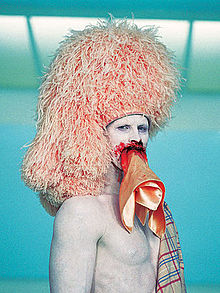- The Cremaster Cycle
-
The Cremaster Cycle 
Matthew Barney's 'Field Emblem' which is a recurrent motif in all 5 filmsDirected by Matthew Barney Written by Matthew Barney The Cremaster Cycle is an art project consisting of five feature length films, together with related sculptures, photographs, drawings, and artist's books; it is the best-known work of American visual artist and filmmaker Matthew Barney.
The Cremaster Cycle was made over a period of eight years (1994–2002) and culminated in a major museum exhibition organized by Nancy Spector of the Solomon R. Guggenheim Museum in New York City, which traveled to the Museum Ludwig in Cologne and the Musée d'art Moderne in Paris from 2002-03. Barney's longtime collaborator Jonathan Bepler composed and arranged the soundtracks for the films.[1]
Contents
Overview
Nancy Spector has described the Cremaster cycle (1994–2002) as "a self-enclosed aesthetic system."[2] The cycle includes the films as well as photographs, drawings, sculptures, and installations the artist produced in conjunction with each episode. Its conceptual departure point is the male cremaster muscle, the primary function of which is to raise and lower the testes in response to temperature.
The project is filled with anatomical allusions to the position of the reproductive organs during the embryonic process of sexual differentiation: Cremaster 1 represents the most "ascended" or undifferentiated state, Cremaster 5 the most "descended" or differentiated.
The cycle repeatedly returns to those moments during early sexual development in which the outcome of the process is still unknown — in Barney's metaphoric universe, these moments represent a condition of pure potentiality. As the cycle evolved over eight years, Barney looked beyond biology as a way to explore the creation of form, employing narrative models from other realms, such as biography, mythology, and geology.
4 1994 1 1995 5 1997 2 1999 3 2002
actual production order of the movies,
compared with numerical orderThe films were not made in numerical order (1–5), but rather in the order 4, 1, 5, 2, 3 – precisely, 4 in 1994, 1 in 1995, 5 in 1997, 2 in 1999, 3 in 2002. The numerical order is the thematic order, while in order of production the films increase in production quality and ambition, and they can alternatively be viewed in any order, as different views of a set of themes and preoccupations.
The films are significantly different in length; the longest (and last-made) is #3, at over 3 hours, while the remaining four are approximately 1 hour each, for a total of approximately 7 hours – #3 itself is almost half the total length. There is precious little dialog in any of the films; only #2 features significant dialog.[3]
An important precursor of the Cremaster Cycle is Drawing Restraint, which is also a biologically inspired multi-episode work in multiple media, also featuring the field emblem.
Availability
As of 2010[update], the films are not available on mass-market DVDs, and according to the press release for the 2010 US tour, the cycle "is Not Now Nor Will it Ever be Available on DVD".[4][5] The films are primarily available via periodic screenings,[6][7] and in bootleg versions, as on peer-to-peer networks.[6]
Palm Pictures, the distributor, has not made the series available on DVD, though there were some rumors and announcements to this effect in 2003.[8][9] So far, only an excerpt, "The Order" (from episode 3) has been released on mass-market DVD.
The full series was released in a limited series of 20 sets of DVDs, sold each for at least $100,000, in custom packaging – as fine art, rather than mass-market movies.[10] In 2007 one disc (Cremaster 2) sold for $571,000.[11]
Reception
Reaction to the cycle is sharply divided – some consider it a major work of art, on a par with Un Chien Andalou and The Waste Land,[12] while others dismiss it as vapid, self-indulgent tedium.[13] This is summarized by one critic as "Barney's cinematic art inspires both awe and revulsion, often simultaneously." Indeed, the Village Voice featured two reviews, with art critic Jerry Saltz praising the cycle, and film critic J. Hoberman panning it.
Lavish praise includes:"The Cremaster Cycle by Matthew Barney is the first truly great piece of cinema to be made in a fine art context since Dali and Bunuel filmed Un Chien Andalou in 1929. It is one of the most imaginative and brilliant achievements in the history of avant-garde cinema."[12] while scathing criticism describes it as "a mostly tedious succession of striking but vacant imagery whose effect diminishes the longer you look at it," from which "any sense of mystery or wonder is drained."[13]
The visuals are roundly praised, however, and some (Hoberman) feel that the movies work well as parts of installations, due to visuals, though not as movies, due to poor editing and pacing.
Further reading
The large volume by Nancy Spector, Matthew Barney: The Cremaster Cycle, is the standard work on the Cycle and contains reproductions of production stills, concept drawings and an exegetical essay by Spector, Only The Perverse Fantasy Can Still Save Us. Neville Wakefield has produced The Cremaster Glossary, which is also included in the book.
Nancy Spector, Matthew Barney: The Cremaster Cycle, New York: Guggenheim Museum Publications, 2002.
References
- ^ http://www.guggenheim.org
- ^ Sex, life and video games; Matthew Barney. The Economist [US], 8 Mar. 2003.
- ^ Cremaster 2 Synopsis
- ^ Cremaster Cycle U.S. Theatrical Release This Spring, Tuesday, March 30, 2010
- ^ Epic masterwork is not now nor will it ever be available on DVD, Chicago Art Magazine
- ^ a b Cremaster Fanatic: FAQs
- ^ Cremaster Screenings – often years out of date
- ^ DVD Talk CREMASTER CYCLE 1-5 from Palm Pictures 9/16???
- ^ "The Cremaster Cycle – Palm Pictures". Archived from the original on 2003-08-02. http://web.archive.org/web/20030802091829/http://palmpictures.com/videos/thecremastercycle.html.
- ^ Cremaster 2 On Sale at Sotheby's New York, October 25, 2007
- ^ Cremaster 2 Fetches Half a Million Dollars, November 16, 2007
- ^ a b (Jones 2002)
- ^ a b (Uhlich 2010)
External links
Sites
- The Cremaster Cycle
- Cremaster Fanatic – The Matthew Barney Fan Site
- Cremaster 1 at the Internet Movie Database
- Cremaster 2 at the Internet Movie Database
- Cremaster 3 at the Internet Movie Database
- Cremaster 4 at the Internet Movie Database
- Cremaster 5 at the Internet Movie Database
Reviews
- Metacritic: Cremaster 3
- Metacritic: Cremaster Cycle
- Jones, Jonathan (2002-10-16), The myth-maker, The Guardian, http://www.guardian.co.uk/film/2002/oct/16/artsfeatures/print
- The Cremaster Cycle, Peter Bradshaw, The Guardian, 17 October 2003
- Uhlich, Keith (20–26 May 2010), "The Cremaster Cycle", Time Out New York (764), http://newyork.timeout.com/articles/film/85835/the-cremaster-cycle-film-review
- Man vs. 'Cremaster': The 10-Hour Test, by John Rockwell, March 23, 2003
- Cults of Personality, J. Hoberman, Mar 11 2003, Village Voice
- Swept Away: On Still Being Smitten With Matthew Barney, by Jerry Saltz, Feb 25 2003, Village Voice
- The Cremaster Cycle at IFC: Matthew Barney exposes his films again, Nathan Lee, May 18, 2010, Village Voice
- Cremaster works, OFFOFFOFF film review, David N. Butterworth
- Time Out Film Guide
- The Cremaster Cycle (2002), Movie Gazette – brief synopsis and review
Other
Categories:- 1994 films
- 1995 films
- 1996 films
- 1997 films
- 2002 films
- Avant-garde and experimental films
- Film series
- Nonlinear narrative films
- Portrayals of Mormons in popular media
Wikimedia Foundation. 2010.


